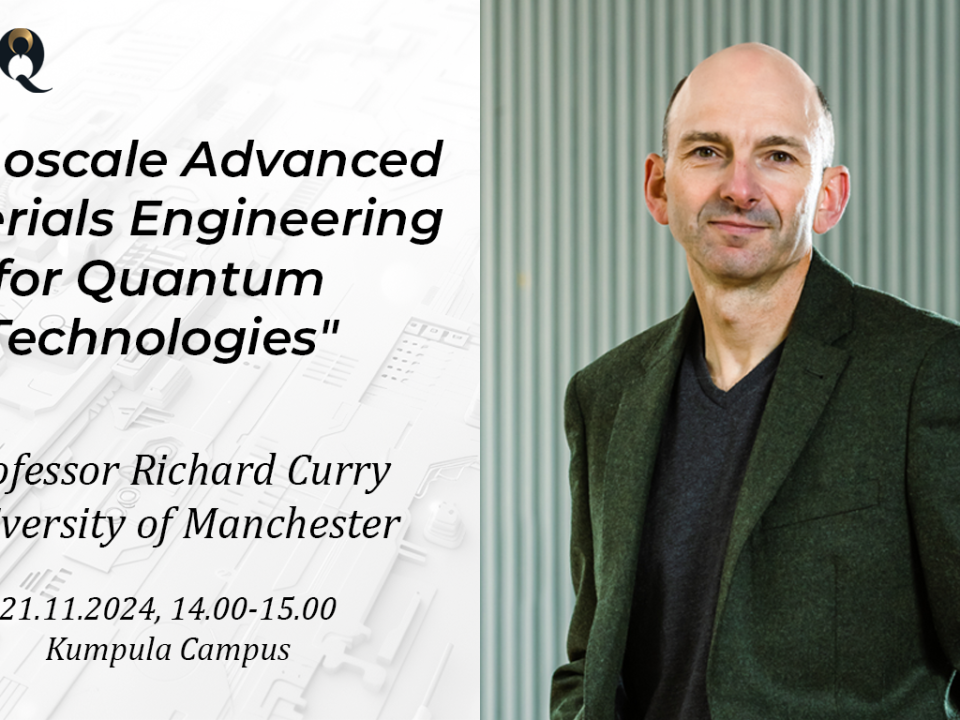
DigiQ talk from Professor Sergey Kubatkin
This DigiQ talk features Chalmers University of Technology Professor and InstituteQ Chair of Excellence Sergey Kubatkin. The title of his talk is "Wafer-scale epitaxial graphene on Silicon Carbide: physics, chemistry, and applications."
Where: Tietotekniikka, Hall C105 T2, Konemiehentie 2, Otaniemi
Register: Webropol link to register
I’ll start from a general introduction into material properties of epigraphene and our advances in uniform doping towards the Dirac point. Unique to epigraphene, anomalously strong pinning of the Fermi level leads to extremely wide quantum Hall plateaux in epigraphene, makes it an ideal material for quantum resistance metrology, opens opportunities for implementation of new, electronic, standard of kilogram in a modern SI system.
Uniform doping of epigraphene in combination with strong intervalley scattering leads to robust quantum localization of charge carriers in graphene, making this material a good thermometer down to 100 mK; application of relatively weak magnetic field allows further extension of the temperature range to sub 100 mK temperatures, providing opportunities for advanced microwave radiation sensing.
The wafer-scale nature of epigraphene allows for measurements on large samples and this facilitates studying the response of this material to THz radiation, where the beam cannot be collimated tightly. I plan to present a couple of examples of response of graphene charge carriers to relatively strong THz radiation. Using epigraphene as a fast thermometer, we have demonstrated a heterodyne detection of THz radiation with promising potential for THz astronomy, outperforming superconductor-based mixers, which are inherently limited both in speed and in the frequency range, particularly for large heterodyne arrays, which are in a high demand among astronomers.
In collaboration with the group of Prof. Pekola at Aalto University we explore an opportunity to use quantum interference of charge carriers in epigraphene for direct detectors of GHz-THz radiation. In our study of electron- phonon coupling in epigraphene to the substrate phonons at mK temperatures, we show that it obeys the T4 dependence characteristic for clean two-dimensional conductor. Based on our measurements, we predict the noise-equivalent power of ∼ 10−22 W/√Hz for epigraphene bolometer at the low end of achievable temperatures and discuss opportunities for a ‘click’ single-photon detection in a frequency range of 10 GHz, relevant for the field of quantum thermodynamics.
Event details
When: 14:00-15:00, 12.6.2024Where: Tietotekniikka, Hall C105 T2, Konemiehentie 2, Otaniemi
Register: Webropol link to register
From Sergey: What will your talk discuss?
Peculiar electronic properties of graphene promise interesting electronic applications, but graphene faces tough competition with mature conventional technologies: semiconductors and superconductors. I plan to describe how these challenges can be met with a wafer-scale graphene grown epitaxially on a wide-band semiconductor Silicon Carbide (SiC) – epigraphene.I’ll start from a general introduction into material properties of epigraphene and our advances in uniform doping towards the Dirac point. Unique to epigraphene, anomalously strong pinning of the Fermi level leads to extremely wide quantum Hall plateaux in epigraphene, makes it an ideal material for quantum resistance metrology, opens opportunities for implementation of new, electronic, standard of kilogram in a modern SI system.
Uniform doping of epigraphene in combination with strong intervalley scattering leads to robust quantum localization of charge carriers in graphene, making this material a good thermometer down to 100 mK; application of relatively weak magnetic field allows further extension of the temperature range to sub 100 mK temperatures, providing opportunities for advanced microwave radiation sensing.
The wafer-scale nature of epigraphene allows for measurements on large samples and this facilitates studying the response of this material to THz radiation, where the beam cannot be collimated tightly. I plan to present a couple of examples of response of graphene charge carriers to relatively strong THz radiation. Using epigraphene as a fast thermometer, we have demonstrated a heterodyne detection of THz radiation with promising potential for THz astronomy, outperforming superconductor-based mixers, which are inherently limited both in speed and in the frequency range, particularly for large heterodyne arrays, which are in a high demand among astronomers.
In collaboration with the group of Prof. Pekola at Aalto University we explore an opportunity to use quantum interference of charge carriers in epigraphene for direct detectors of GHz-THz radiation. In our study of electron- phonon coupling in epigraphene to the substrate phonons at mK temperatures, we show that it obeys the T4 dependence characteristic for clean two-dimensional conductor. Based on our measurements, we predict the noise-equivalent power of ∼ 10−22 W/√Hz for epigraphene bolometer at the low end of achievable temperatures and discuss opportunities for a ‘click’ single-photon detection in a frequency range of 10 GHz, relevant for the field of quantum thermodynamics.
Related posts
08/10/2024



